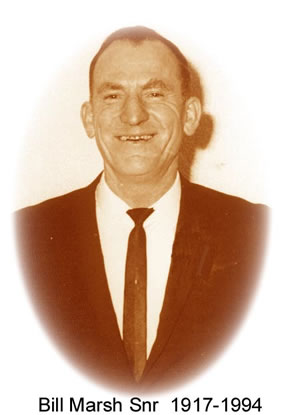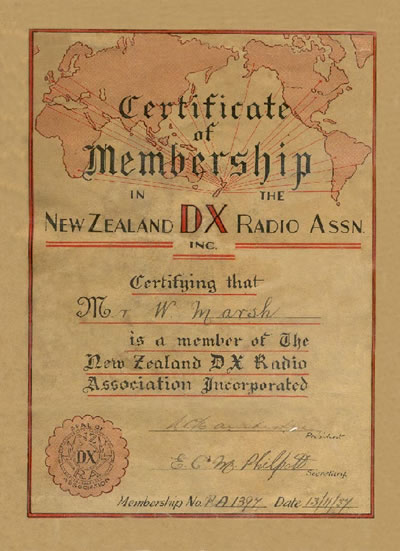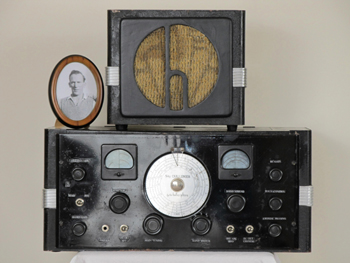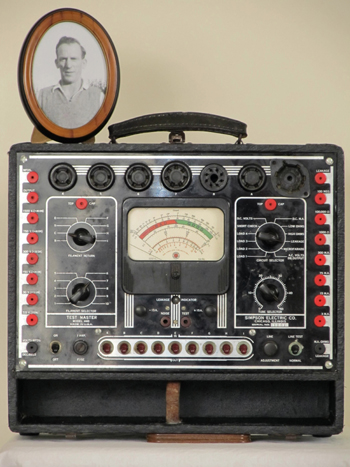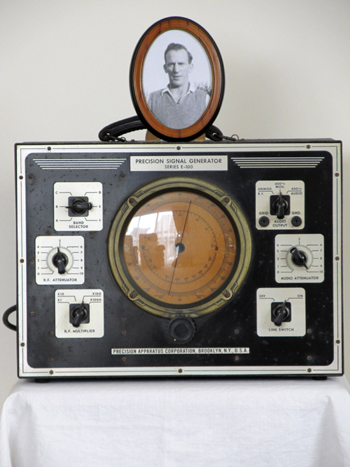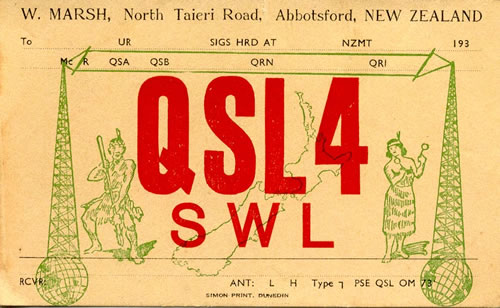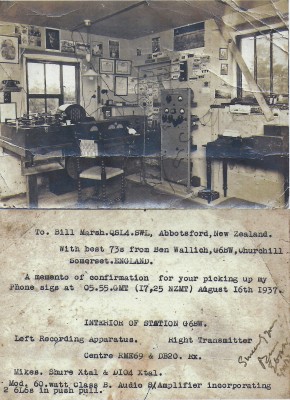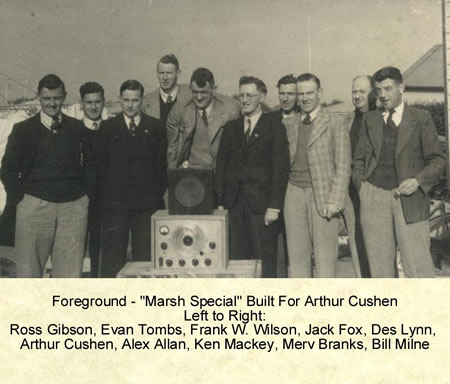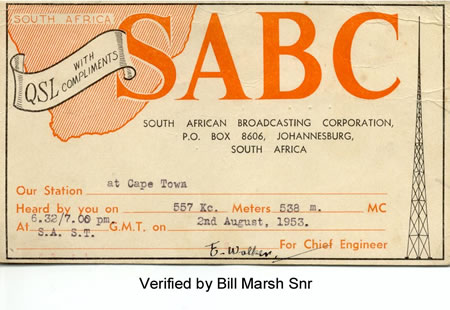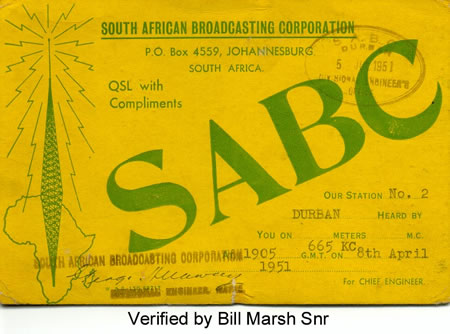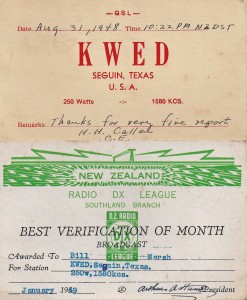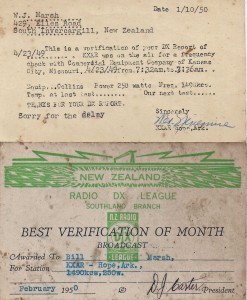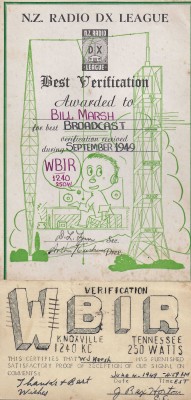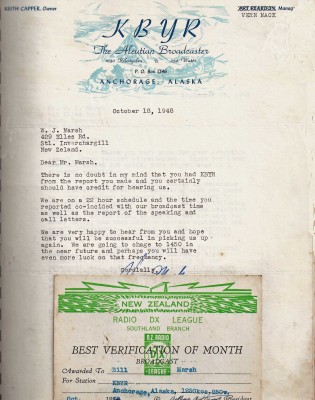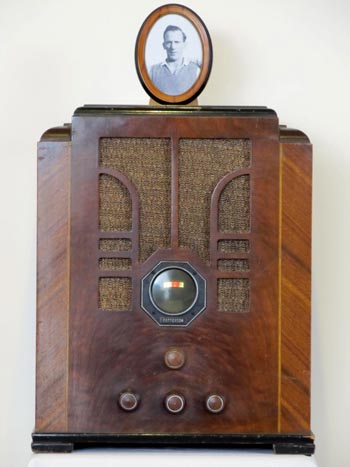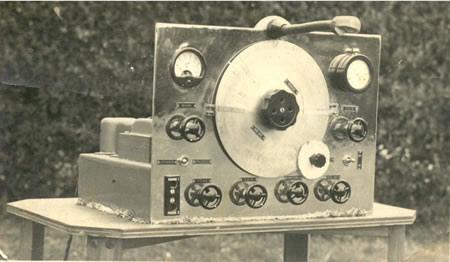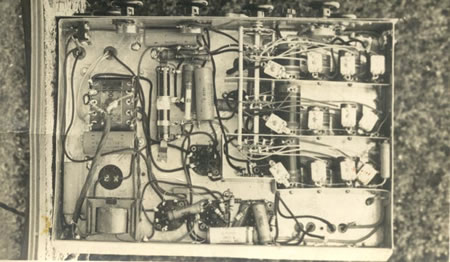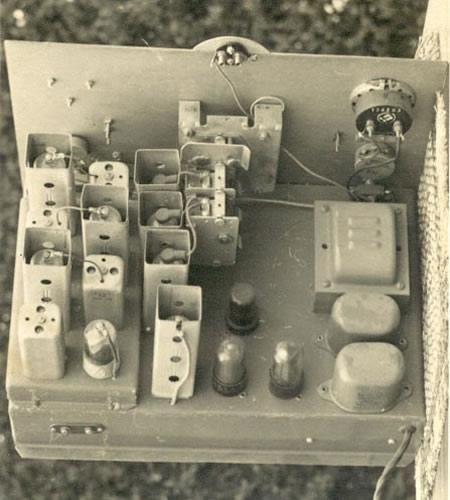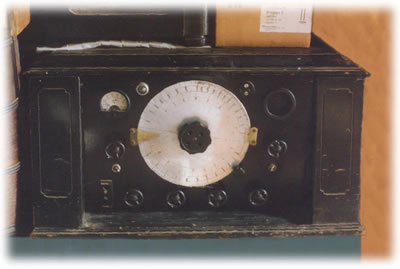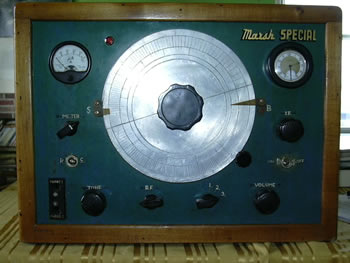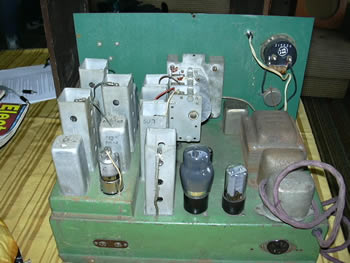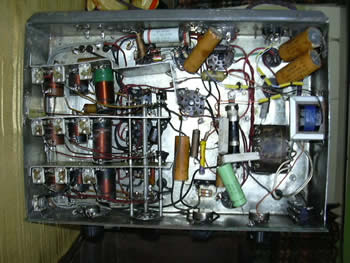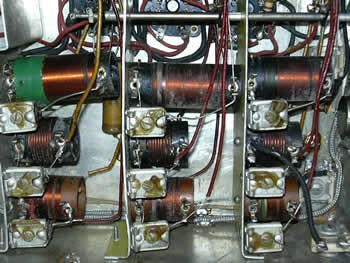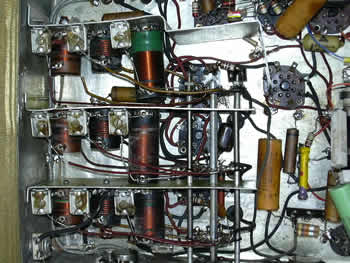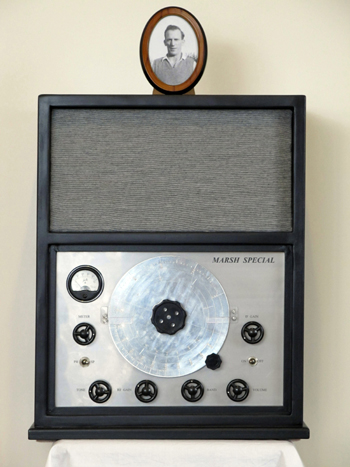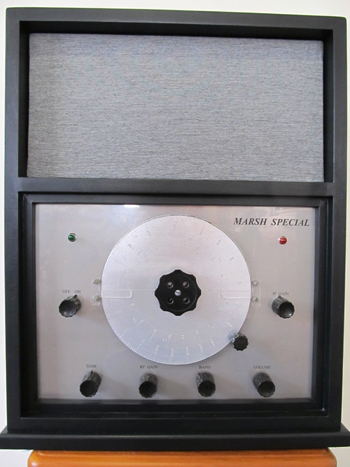BILL MARSH (SNR.) & “THE MARSH SPECIAL” TRIBUTE TO AN NZ DXER
(The “MARSH SPECIAL” Super DX Receivers he designed and built. This article includes some Reminisces of other Southern DXers & listening Posts).
These lines were penned by Bill Marsh Junior in 2002 and a DXer for a few years either side of 1960. I grew up with radios and signals all around me, so DXing, radio construction & repairs were very soon running in my blood. In 1992 I became a very active genealogist and started asking a lot of questions about family members and naturally enough started probing my father regarding his achievements in life. Unfortunately it was never expected that he would pass away so early in life so a lot of questions were never asked. The answers perhaps will be lost forever. Note: There is a moral to this story for others to follow, and that is, “never put off till tomorrow what you should do today”.
William James Marsh Senior was born at Kaitangata but did most of his growing up in Colac Bay, a small settlement West of Riverton on the southern coast of the South Island during the 1920’s. His father died towards the end of 1930 and the family moved to North Taieri Road Abbotsford, (a suburb of Dunedin), enabling them to be closer to his mother’s family. A neighbour of the family in Abbotsford owned a valve radio which held a fascination for Bill from an early age. His own family did not own one as in those times one was considered a luxury. Consequently Bill spent a lot of time at the neighbours twiddling the dial (or dials) whenever the opportunity arose. During this period the radio broke down and the owner decided to buy a new one. Bill asked if he could have the old one to see if he could work out what made it operate. The reply was that if he could get it going he could have it. Apparently it took only about a week of tinkering and he had it working again. For someone who had had no secondary education and no mentor this was an amazing achievement. From a “Who’s Who” article in the July 1952 “NZRDXL Times” (monthly magazine of the New Zealand Radio DX League) it is confirmed that he was about 15 years old at this time (1932).
This was the beginning of a long association with radio and the DX hobby. I suspect that he would have listened to many overseas radio stations during these early years and it is likely he would probably have been oblivious to the hobby of DXing. He started DXing in 1936, when he became friends with Frank Barnett (then of 4YA 1952 and formerly of 4ZO) who was a one-time DX champion. The first DX receiver he used was an 8 tube Patterson. An International Log from a NZ DXer. He became a member of the “New Zealand DX Radio Association” (RA) in Dunedin. His membership number as at 13 November 1937 was RA1397.
By the outbreak of WWII he had purchased new; a Hallicrafters Sky Challenger SX-18 communications receiver, Simpson model 440 VTVM-Valve Tester and a Precision series E-100 Signal Generator. He DXed extensively during this period and had accumulated some 500 verifications and QSL cards before going overseas. His first verification was VK7RY Tasmania. VK6MU operating on 1420 kcs logged in 1938 was apparently one of the first calls of importance. It is assumed that this station would have been operating on quite low power.
He had his own QSL card (above) which was undoubtedly used as a 2 way exchange with hams. Unfortunately whilst he was overseas in Egypt his mother remarried and shifted house and consigned his verifications and QSL cards to the furnace.
The same fate may have been bestowed upon his radio equipment but for the fact that they had been impounded for the duration of the war by the defence department. I recall conversations with him about the time I became interested in DX, that a good number of those verifications and cards were irreplaceable. In those days hams were able to operate on the standard (broadcast) medium wave band above 1500 kc and a number of experimental stations were also operating, pioneering the way for commercial broadcasting. From all accounts the broadcast band was alive with stations from North America in the evenings. Some of the lowest ever recorded sunspot cycles occurred during these early years of radio, so very necessary for exceptional medium wave reception. With few stations in New Zealand operating on shorter hours, and the lack of TV QRM must have provided phenomenal listening conditions for these old timers. (If only those days could be brought back with the modern receivers of today.)
On his release from active service he became a radio serviceman for McCracken & Walls in Dunedin and shortly after they asked him to transfer to their branch in Invercargill. During this period he used his own test equipment. A change of management and a change in direction by the company in 1947 resulted in Bill resigning and taking up employment with NZ Railways. By this time the new house at 429 Elles Road South Invercargill would have been well established and most probably the large radio workshop. A number of his ex McCracken & Walls customers had followed him to his home address, and, as in the words of some, nobody could fix radios like Bill could. This was the start of a backyard business that perhaps in hindsight could have flourished and prospered. However he chose to treat it as a hobby and did all repairs on a “mates rate” basis. He joined the Southland Branch of the NZRDXL in July 1948, becoming a member of the League from it’s inception.
In September of that year he offered a radio repair and alignment service to fellow DXers. This remained the order of the day untill well into the 1970’s when his interest waned due to the ever increasing number of transistor radios. He was a valve man through and through. Reference to old “NZRDXL Times” shows that he was a member of the “League – Board Of Directors” for the terms 1949/51, 1952/54 and 1955/56. The 1952 annual report of the Southland Branch shows Bill as Vice President and Log Keeper. The location at 429 Elles Road was absolutely ideal for beverage aerials, as there was a long row of macracapra trees on a distant western boundary. Three aerials in all were erected, being some 450 feet long headed in a N.W., W. and S.W. aspect. Bill at this time was strictly a broadcast band DXer. The one to the S.W. was to prove the most rewarding as this gave rise to verifications from South Africa and the eastern states of the USA.
This location became a very popular destination for a great number of southern DXers, a number of whom did not have the long aerials or the equal of the Hallicrafters receiver. The Hallicrafters was set up in the kitchen and was very rarely turned off. Late night sittings occurred on a regular basis with anything up to 2 or 3 DXers at a time. Monthly meetings of the Southland branch of the NZRDXL were held here also at regular intervals. His wife, Nancy, would usually busy herself in the kitchen making supper whilst the men had their meeting in the sitting (or lounge) room. After supper a number would stay behind and start twiddling the dial. She was always very supportive of the DX hobby and what went with it. All DXers were made very welcome in our home. She especially looked forward to the arrival of the postie each day and the goodies that were dropped into the mailbox.
A number of them made comment over the years on how pictorial the cards, envelopes and stamps were and wondered what sort of people lived at this address to generate so much mail on such a regular basis from all over the globe. The workshop was also a very popular haunt for a great number over the years, where repairs, tune-ups, construction and retro-fitting occurred. Naturally enough a great number of stations were logged here also. Some DXers from as far away as Dunedin even came down to have their sets tuned and one in particular made it an annual event.
Some of the personalities that spring to mind that were DXing in and around Invercargill either side of 1950 were Alex Allan, Merv Branks, Dudley Carter, Peter Chin, Alan Corner, Arthur Cushen, Des Frampton, Allan Fraser, George Goodsir, Des Lynn, Eddie MacAskill, Eric McIntosh, Bill Milne, Derek Morris, Noel Parry, Brian Ramage, Keith Robinson, Des Smith, Merv Smith, Bert Thompson, Bill Thomson, Evan Tombs, Lloyd Warburton.
It appears that the branch at this time was very active socially, with mention of Bill roller skating & playing soccer to name just some of the activities. He was Convenor of the Social Committee in 1955 and most probably involved in other years as well.
Bill logged and verified some very rare stations from number 429, a great number of which were awarded “Best Verification” of the month etc. Pride of place are 10 verifications from the (SABC) South African Broadcasting Corporation (A NZ record and thought by some to be a world record);
Capetown 557 kc, Bloemfontein 620 kc, Durban 665 kc, Pietermaritzburg 701 kc, Johannesburg 728 kc, Bloemfontein 809 kc, Johannesburg 836 kc, Pietersburg 863 kc, Pretoria 1268 kc, Pretoria 1439 kc.
Some 250 watt Stations verified:
From North America; CHWK Chilliwack BC 1230 kc, WBIR Knoxville Tennessee 1240 kc, WJLB Detroit Michigan 1400 kc, WOND Pleasantville New Jersey 1400 kc, WPAM Pottsville Pensilvania 1450 kc, WPAR Parkersburg West Virginia 1450 kc, WSIP Paintsville Kentuky 1490 kc, WTMV East St Louis Illinois 1490 kc, WWDC Washington DC 1450 kc, KBYR Anchorage Alaska 1240 kc, KCIL Houma Louisiana 1490 kc, KCOW Alliance Nebraska 1400 kc, KICO Calexico California 1xx0 kc, KLMR Arkanasas Valley Colorado 1340 kc, KMHL Marshall Minnesota 1400 kc, KREW Sunnyside Washington 1230 kc, KSEO Kovers S.E. Oklahoma 750 kc, KWED Seguin Texas 1580 kc, KWIN Ashland Oregon 1400 kc, KWKC Abilene Texas 1340 kc, KWSO Shafter California 1050 kc, KXAR Hope Arkansas 1490 kc.
From the Pacific; KIKI Hawaii 860 kc, KTOH Hawaii 1490 kc, WWTV AFRS Johnstone Is 1250 kc, KCMB AFRS Subic Bay 1520 kc (200 watts).
Over the years some interesting comments were added to various verifications by Station Engineers and like staff. Thes.e are reprinted in this article.
In the June1950 issue of the Southland Branch Digest it is announced that Bill is well into the building of a super DX receiver to become widely known as the “MARSH SPECIAL”. By July 1952, six Invercargill DXers were owners of one of these receivers. Where the inspiration came from for this receiver I never did find out, but I suspect a number of DXers had approached him after he had built and proved a prototype receiver. Over the preceding years he would have serviced a number of American receivers and I know he used to talk often of the Pattersons’ in particular. One such Patterson is still in my possession and I can clearly see where the sub-chassis idea for the IF stage in the “Marsh Special” came from. This receiver lay under the bench in his radio workshop for as long as I can remember. It is only since gaining access to old “NZRDXL Times” that I have realised that this was his first DX receiver. The model number of this Patterson chassis is not visible, but it is an 8 tube (6D6 series) receiver with full coverage from 540 kcs to 28 mhz in five bands. The tuning gang is split for partial bandspreading on the four shortwave bands. There are three tuned circuits (432 kcs) in the IF stage which would give it very good selectivity. I had intended to restore this receiver for my collection, however it now takes on more significance. (In 2011 this receiver was identified as a model 185AW manufactured in 1934. After some searching a cabinet and spare chassis was subsequently obtained through the NZ Vintage Radio Society, leading the way to full restoration.) He often talked to me about the precision of the band changing and tuning mechanisms of some of the captured German & Italian receivers that he tinkered with whilst in Egypt. Perhaps the concept of the Marsh Special started as a dream to help occupy the endless hours spent in the Egyptian desert.
The “Marsh Special” in its basic form was an 11 valve receiver, (below) specifically built for broadcast DX but very capable also on short waves. The broadcast band was split into two segments tuning 540 kc to 1200 kc on band I and 920 kc to 2000 kc on band II. Each receiver had a short wave band covering 8.5 MHz to 18 MHz which in addition to providing short wave coverage gave access to time signals from WWV on 10 & 15 MHz. Some, at the request of their prospective owners had a fourth band covering the range between 2 MHz and 8.5 MHz with some overlap. This band also gave access to WWV on 2.5 & 5 MHz. Any signal received from WWV on 2.5 MHz was always considered by me, a first indication of how good the receiver and aerial system was. Some models were fitted with a pocket watch holder on the front panel for time keeping purposes.
The R.F. stage was single stage, but used 2 tubes (type 6U7G) connected in parallel for higher gain. The gain of this stage was controlled from a front panel control.
The oscillator/mixer stage was pretty conventional using a 6K8G.
The three sets of coils associated with these stages (9 in all for a three band receiver) were all hand wound on 1″ diameter impregnated coil former. The tuned windings were all wound using single copper enamelled wire and the coupling windings were wound over the earthy end of the main winding using silk covered multi-strand litz wire. The primary winding of the aerial coil was wound to suit long wire beverage aerials. The exercise as I recall was one of deep concentration, counting turns, keeping all tight, together and not overlapping. The whole exercise resulted in severe eye strain as I experienced also a number of years later. Three strips of aluminium (approx. 3″ W x 8″ L) were used to mount the coils on. The three strips were equally spaced & secured via the long machine screws and spacers on the wave change switch assembly.
This sub-assembly was pre-wired i.e. coils to wafer switches and variable trimming capacitors, including fly leads to the main chassis etc. The main chassis was fully wired with all components fitted before this coil assembly was screwed into place and fly leads connected. Some models had a green & red bezel light on the front panel which was wired to the wave change switch. The idea on a three band receiver was green for say band I, red for band II and both for band III.
The I.F. stage which was built on a sub-chassis consisted of 4 double tuned circuits (458 kc), 3 amplifier tubes (type 6U7G) and a double diode tube (type 6Q7G) using the diode elements only for am detection. The I.F. coils/cans were purchased new and were quite high Q for their time. These I.F.’s in conjunction with the number of I.F. amplifier stages provided excellent selectivity for am reception. The gain of this stage was also controlled from a front panel control.
The dynamic range of the A.V.C. (automatic volume control, later referred to as automatic gain control) system was quite wide but as with any receiver of such gain, use of gain controls had to be made when tuning into local stations. It was generally sufficient to back off the R.F. gain control. There was a procedure for setting the gain controls, i.e. with the R.F. gain backed off the I.F. gain was increased to a position just before the receiver started to regenerate.
The R.F. gain control was then increased to maximum setting and you were under way. A tuning meter was provided on some models to aid tuning and to give some indication of signal strength. This meter was driven by a 6C5 metal type which derived its signal voltage from the AVC circuit. A meter zero adjustment control was on the front panel which was adjusted (if required) following the setting of the R.F. & I.F. gain controls.
The audio amplifier was a single stage class “A” amplifier using a 6V6 GT in the output and 6S7 G as the driver. Output of this stage was wired to a double phone jack on the front panel which could be used to supply audio to an external loud speaker or headphone set as the owner wished. The double jack allowed for the use of two ZC1 type headphone sets to be used together to facilitate companion DXing.
The power supply was also very conventional and consisted of a full wave rectifying circuit derived from a heavy duty transformer supplying 310-0-310 volts for H.T., 6.3 volts for receiver tube filaments plus any panel lamps and a 5 volt winding for the rectifier tube. The high voltage winding was rectified by a 5Y3 GT and filtered by two electrolytic capacitors and a smoothing choke to provide the high voltage DC supply for the receiver. The resultant DC output was hum free even with very weak radio signals. The full DC voltage was applied to the output stage and a range of lesser voltages applied to different sections of the receiver. One high wattage resistor with tapping off points was used with respect to earth as a voltage divider for some of these lesser voltages. The oscillator/mixer stage derived its voltage directly from the output of the 5Y3 GT via its own R/C filter network to provide a sufficiently stable voltage to eliminate drift in the oscillator section.
The main chassis and sub-chassis were made from 18 g tin steel, which were cut out, bent and the joining edges seam soldered, all by hand. After the shaping of the chassis was complete all holes were drilled as per his pencilled layout plan. Larger holes for valve sockets were punched out using hole punches he had turned on a lathe at the NZR loco workshops. The outer parts of the chassis visible to the eye were painted bottle green (a favourite colour of his) and the underside left clean for soldering tag strips and earthy ends of components etc. After a suitable drying period any holes that were to have wires pass through them were fitted out with rubber grommets. Both chassis were then ready for the fitting of all mechanical components as a pre-requisite to actual wiring.
The front panel was also made of tin steel which lent itself well to taking a good shine. On some models a flexible arm instrument light was mounted on the front panel, central to and above the circular dial to assist with dial illumination.
A number of components used were from ZC1 (MKII) transceivers made available for sale after WWII through “Sinewave George” a well known radio dealer in Wellington. I well recall as a lad large numbers of these arriving in our kitchen over a period of time.
Used from these transceivers were; the tuning gangs complete with the dial shank/knob assembly and tuning mechanism. The three gang tuning capacitor and all associated mechanical mounting parts were screwed to the front panel and floating above the main chassis. Earthing of the gang to the main chassis was by means of tinned copper flexible braid. The tuning idea and mounting arrangements of the ZC1 were adopted except that the dial plate was made larger in diameter.
These dial plates were made from 18g aluminium and all circular and calibration marks scribed by hand. Frequency numbers were stamped on using number punches. This latter process was only carried out after the receiver had been built and aligned and calibration marks pencilled in. This method allowed for individuality and precise calibration. Two dial pointers were made from thin clear perspex and screwed either side of the dial for frequency indication. Also used from these ZC1’s were the; valve shield assemblies, selected valves, meters, flexible arm instrument lights and their sockets, pocket watch holders, double line/headphone jacks and the headphone sets.
The choice of valves was made easy as boxes of them could be purchased new in large quantities from “Sinewave George” ex the war ministry. All other components were purchased new from Turnbull & Jones an electrical and radio parts business in Invercargill. When Bill first moved to Invercargill he was instrumental in advising Turnbull & Jones what to stock in regards to radio lines. He was allowed to purchase components at wholesale price for his own use up until they reverted back to an electrical only supplier in the late 1950’s.
There were some 17 “Marsh Specials” understood by me to have been built. The June 1950 issue of the Southland Branch Digest reports 7 to 12 being built at # 429 by their respective owners under Bill’s watchful eye. From what I recall most remained in Southland and some of the personalities referred to earlier were the recipients of some, however a few went north, and as I understand one ended up in Australia.
Some of these receivers were still being used in the 1970’s and by this time a number had passed on to second generation DXers. It would be impossible to attribute the number of verifications accredited to the “Marsh Specials” but given their performance and length of service would probably amount to several thousand.
The prototype referred to earlier was from what I remember the largest of them all. It had four bands, all the “bells and whistles” on the front panel and had 14 valves. The extra valves were all in the audio stage which was high quality push pull using a pair of 6F6 G tubes connected as triodes in the output driven by push pull 6P5 GT tubes and a 6N7 GT as preamplifier and phase splitter. Bill had experimented with hi fi amplifiers before WWII. The transformer in the power supply was of a higher wattage and HT voltage. A 5Z3 was substituted for the 5Y3 GT to handle the higher current drawn by the push pull amplifier. This receiver was fitted into a tall console cabinet and with it’s overall performance was something very special. I am also absolutely positive the coil assembly was totally enclosed in copper. I am guessing here a little, but I understand that this was the receiver he sold to a bachelor uncle of Des Smith referred to earlier. He often commented to me that he wished he had never sold this receiver. This receiver came up for auction in an estate sale after Alec Smith passed away, and although Bill attended the auction the bidding went way beyond his bidding range.
The cabinet choice was left to the respective owners to sort out. A number were fitted into ex commercial radio cabinets both table size and console. Some never made it into cabinets. One cabinet that always sticks in my mind was the one used by Merv Branks. (see also appendix “A” for recollections) This was a large wooden cabinet with a lift up lid that had housed a rather large T.R.F. type radio. I remember it well as I got to pull the radio section to pieces as a lad salvaging gangs etc. to make crystal sets. What I wouldn’t give today to have this radio in my valve radio collection as it’s appearance along with all the front panel controls as I recall was most impressive. This “Marsh Special” housed in this cabinet was nick named “The Bradionx”.
In addition to the building of the “Marsh Specials” a number of American and Phillips type receivers that had all the necessary stages and suitable tuning ranges were retrofitted. This process involved changing the valves to the EF39 or EF41 series which had lower filament consumption, and in conjunction with a vibrator pack could be used for reasonably long periods from a 6 volt heavy duty car battery. It was general practice to change all the capacitors and resistors as part of the process. The changed valve characteristics invariably necessitated this change. These made them ideal for taking to remote DX locations a good number of which performed very well. Probably the most memorable one was that owned by Merv Branks. (see also appendix “A” for recollections) This was a Phillips or Mullard (type 593 etc) with a slide rule dial along the top and was used over a great number of years at the “6×3” his famous listening post at Riverton Rocks.
A number of commercial communications receivers passed through the workshop over the years namely; Hallicrafters SX 28 belonging initially to Arthur Cushen and latterly Des Frampton, my own Hallicrafters SX 28A, Eddystones belonging to Eric McIntosh & Eddie MacAskill & Laurie Boyer and a Hammarlund HQ120X belonging to Sutton Burtenshaw to name a few.
The December 1955 Southland Branch Digest lists Bill having 433 QSL’s on B.C. For some reason never explained to me around 1957 he chose only to log stations and not send out reports. He seemed quite content just to have experienced the thrill of hearing a new station without the need to prove to others that he had done so. The element of competition did not seem to be something he needed. He did however donate a trophy to the Southland branch sometime after this date. It became known as “The Marsh Trophy” intended for the most outstanding junior member of the branch to encourage young members. The first recipient was Ray Crawford in 1961/62.
By 1960 the aerial system at # 429 had become somewhat restricted with the loss of the aerial to the S.W. in 1952 due to housing development, the one to the west a few years later and accordingly Bill explored a large block of land at Otatara belonging to a friend of his. He had two purposes in mind, being gardening and DX. He did the gardening (his other great passion in life) and I did the DXing. I was still at high school at this time and with Ray Crawford was able to bicycle to this location, carrying with us a battery powered Cromwell receiver including all the necessary and bulky dry cell batteries, and all the gear needed for a weekend dxpedition. After we both started work and had vehicular transport available, the Hallicrafters SX-18 was adapted to run from a vibrator pack. There was some restrictions at this location for aerials as we were not allowed to cut down any of the native trees.
Despite this however this location proved very good and in addition to North American broadcast DX some very good South American’s were logged also. I am pretty sure it was from this location that we logged Mauritius on 683 kc. Ray was the only one to send a report away and was suitably rewarded with a verification. Some other DXers to frequent this location were Des Frampton & Eddie MacAskill. A Club Meeting was held here for the first time in July 1964 in which 15 attended. This post was used for a good number of years even after I left the district. The Hallicrafters continued to be used at this post until the mid 1970’s at which time I took possession of it for restoration. By now the famous listening post at Tiwai was established. The suitability of the Tiwai area had been understood for a good number of years except that it was not easily accessible until after the bridge servicing the aluminium smelter was built. The world famous Awarua Radio site being nearby and Keith Robinson used to DX for many years with excellent results from Lake Waituna a little east of the present Tiwai listening post.
Acknowledgements:
Paul Ormandy (Oamaru) For prompting me to write this article and for taking the responsibility for publishing and adapting same for the NZRDXL Web Site.
Ray Crawford
(Brisbane – Australia) For his valued recollections and research into old NZRDXL Times.
Jack Fox (Dunedin) For his recollections of earlier times and the supply of photograph (WJM009)
Paul Aronsen (Invercargill) Research into old Southland Branch Digests and co-ordinating comments from other Southland Branch members.
Eric McIntosh (Invercargill) For his recollections of earlier times and the supply of photograph (WJM010)
Eddie MacAskill (In’gill) For his recollections of earlier times and names of 1950’s DXers.
Above photos of Eddie MackAskill’s “Marsh Special”
(Credit: Ray Crawford)
Paul Aronsen of Invercargill is the present owner of the Marsh Special formerly belonging to Eddie McAskill and featured in the web article. It was Eddie’s wish that Paul take ownership after he passed on. This radio has been kindly returned to the Marsh family by Paul in 2014 for heritage reasons. The radio has been restored to full working order by Bill Marsh (Jnr), the details of the restoration are published in this article.

